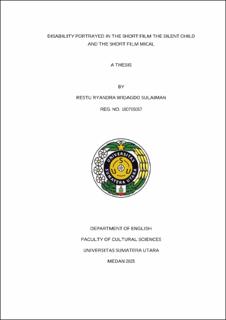Disability Portrayed In The Short Film The Silent Child And The Short Film Mical

Date
2025Author
Sulaiman, Restu Ryandra Widagdo
Advisor(s)
Sumbayak, Desri Maria
Syahputra, Fikry Prastya
Metadata
Show full item recordAbstract
This research examines the portrayal of disability in the short films The Silent Child (2017) and Mical (2020) through a detailed character analysis of their protagonists Libby, a deaf child, and Mike, a dyslexic boy focusing on their physical, psychological, and social dimensions. The study reveals both similarities and differences in how disability is depicted in The Silent Child, cinematic techniques such as framing, close-ups, and body language emphasize Libby’s isolation in a hearing centric environment that limits her ability to communicate, while in Mical, the visual presentation of Mike’s frustration and emotional turmoil underscores a rigid educational setting that fails to accommodate his dyslexic learning style. Despite differing contexts, both films critically reflect how systemic neglect and cultural misconceptions shape these characters’ experiences, highlighting their internal struggles and the transformative potential of supportive interventions. Ultimately, the analysis argues that disability is not an inherent deficit but a socially constructed experience, reinforcing the need for more inclusive communication and education practices that address both the shared challenges and unique circumstances of disabled individuals
Collections
- Undergraduate Theses [873]
